A review copy of Between Two Castles: Essential Edition was kindly provided by Stonemaier Games. Thoughts & opinions are my own.
I have to admit, I was confused for a while when it came to the ‘Between two…’ series and the ‘Mad King Ludwig’ games. It started with Between Two Cities and Castles of Mad King Ludwig; two separate games from two different designers and publishers. Then came the crossover – Between Two Castles of Mad King Ludwig. After that, we had Between Two Cities: Essential Edition, Castles of Mad King Ludwig: Collectors Edition, and now the game which seems to tie it all up with a nice, neat bow: Between Two Castles: Essential Edition, and I can stop trying to figure it all out. The great news is that it seems to take all of the best bits of the previous games and sticks them all in a single box, and it’s a very nice box indeed.
Competitive cooperation
There are a bunch of games that come with the badge ‘semi-coop’ stuck on them. Some people hate that term and decry it as something that’s just not possible. It’s either competitive or cooperative, not both. While I don’t agree with that dichotomy (Moonrakers, which I reviewed here, is a great example of semi-coop), there’s no doubt that Between Two Castles is in a category with not many other games. Games like Splito and Medium. It’s a game where the player with the highest score wins – naturally – but to get a high score, you need to cooperate with your neighbours. Both of them.
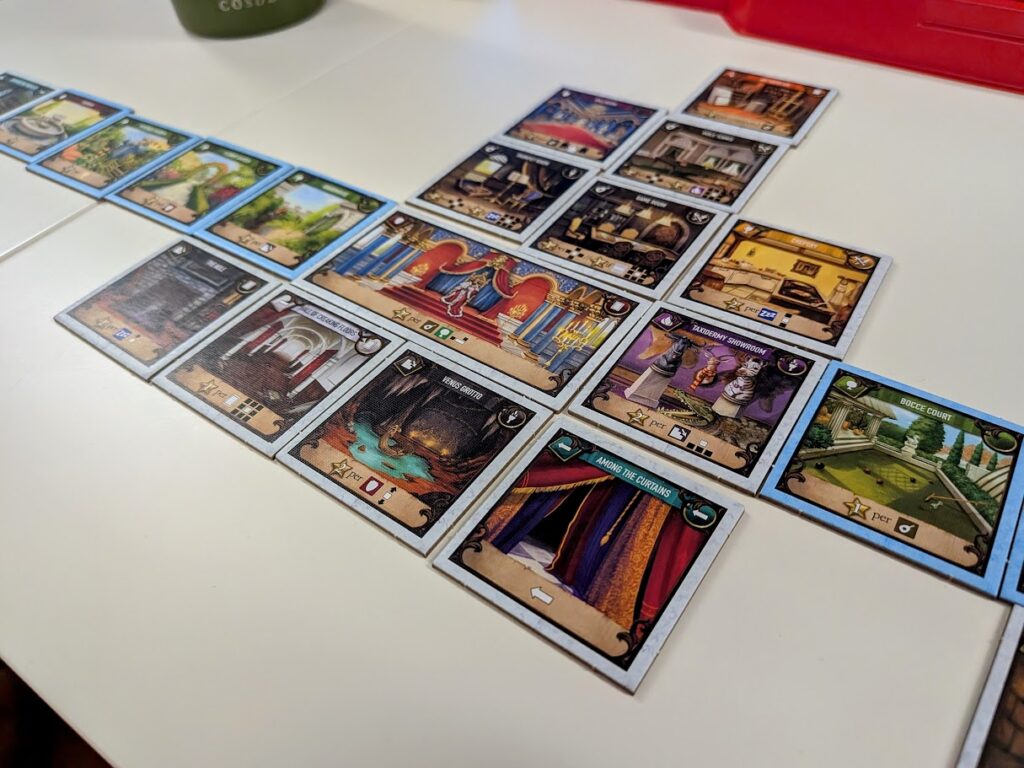
Between you and your neighbours on either side, there’s a throne room tile – the foundations of a series of castles. On your turn, you draw two tiles from the stack in front of you and choose one to place in the castle to your left, and one for the castle on your right. Every other player is doing the same, so each castle grows by two tiles each turn. The tiles represent rooms of different types. There are bedrooms, activity rooms, food, living, corridors and others. There are even outdoor spaces. Each tile has a scoring condition based on its type and the icons printed on it. You need to place tiles with a strategy in mind, but obviously, there’s an issue. Two of you are doing building work in each castle, so how do you go about it?
You talk. You have conversations with the players on each side of you where you try to decide where to place the tiles you have, and maybe which tiles you’re looking for for the future to best score with what’s already in your Schloß. In a semi-coop game, every deal you make, every temporary pact in place, is one you’re trying to shape in such a way that it benefits you more than the other person. You can’t do that in Between Two Castles, though, because your personal final score is the lowest of the two castles next to you. You actually want to do your best on both sides. You can’t try to use all of your ‘best’ rooms on one side and use the other side as a dumping ground, because one side will score poorly, and you’ll lose.
Table talk
Between Two Castles is very much a social experience. Talking to your neighbours is mandatory; otherwise you have no idea what your shared castle is doing, and how you can best score from it. It means there’s a lot of time talking to the person to your left, and then to your right, and it’s these discussions which determine how long each game takes. This aspect of the game might not appeal to you if you are a dyed-in-the-wool euro gamer who loves nothing more than coming up with your own strategy and executing it. Half of the rooms in each of your castles are provided by someone else, after all.
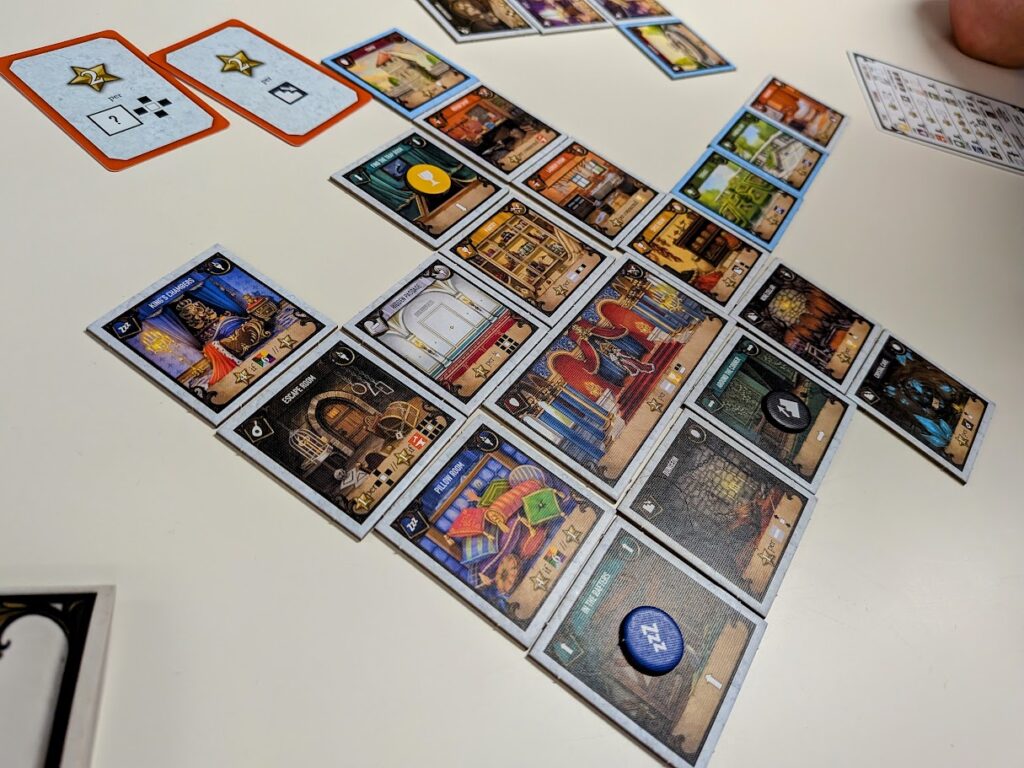
One of Between Two Castles’ greatest strengths is the wide range of player counts it covers. There aren’t many games out there that you can take along to your local game night and be confident that you’ll be able to play it before knowing how many people will show up. It supports one to eight players, which is a crazy range for a non-party game. I’d argue that anything below four players isn’t really as much fun as playing with higher player counts. I’d rather play a different game, I think. But once you have more than four people sitting at the table, that’s when Between Two Castles has its ‘hold my beer’ moment. It just works, and you can see how it could theoretically (with multiple copies of the game) scale up to almost any number of players.
The biggest issue you’ll come up against in keeping people interested and wanting to play the game again in the future is the seating order. If you’ve got a few newbies and a couple of people who’ve played the game even once before, split those players up. Despite the principles of the game being relatively simple, it’s quite hard to execute in your first game or two, and having an experienced player guide you and your strategy really makes a difference.
A night on the tiles
Your biggest task before playing Between Two Castles is getting the game punched and sorted. The included GameTrayz inserts do a fantastic job, both in the box and on the table, but there’s a lot to organise first. We’re talking over 300 tiles! I hope your thumbs are up to the job.
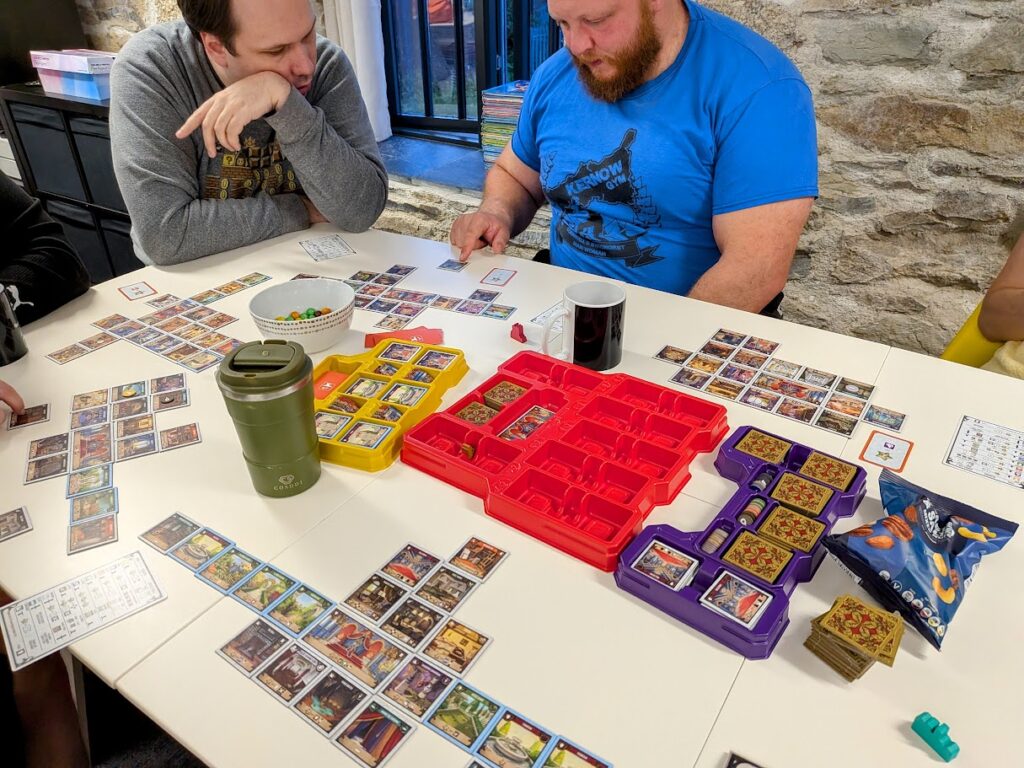
The tiles themselves are fine. Not especially brilliant, but not especially poor either. The colours and icons are small, but discernible. The biggest issue you’re likely to come up against is the iconography. Every tile has its scoring conditions printed on it, and this is fine while they’re in-hand and you’re choosing two for the coming round, but when they’re on the table and to one side of you, you’ll have to start relying on your memory or your glasses, whichever you have to hand. Trying to remember and enact multiple strategies is hard enough to begin with, before you factor in trying to spot the icon on the bottom of a tile 12 inches away from you. Definitely always play in a well-lit room, too.
If you’re overly precious and anal about scoring and rules adherence, Between Two Castles might cause you sleepless nights. There’s absolutely no way you can know what’s going on in any of the other castles around the table, so you’re reliant on the other players knowing what does and doesn’t constitute a legal placement for a tile. Worse still, the way the scoring works means that each player evaluates just the castle to their left. You have to trust everyone else around the table and their ability to accurately and fairly score their designated castle.
Please don’t be that person who checks each and every castle personally. If someone asks you to check, fair enough, but this isn’t the game to go full Rules Lawyer on.
Final thoughts
In a way, Between Two Castles reminds me of 7 Wonders. Not because they’re especially similar, but because they’re one of those few games that get pulled off the shelf because you have a big group around the table, and you know they don’t want just another game of Codenames or Skull. It doesn’t feel like a concession to choose to play it. It’s not like you’re thinking “I guess we’ll have to play Between Two Castles and make the most of it”, because Between Two Castles is good.
In fact, if you regularly attend a group where you have new players from time to time, Between Two Castles is a brilliant option. It’s a game which can bring everyone together to play, letting experienced players help newcomers, and still offer a really decent tableau-building experience. It’s a fantastic option, and a great way to give people their first steps into this hobby.
If you’re an old hat when it comes to tableau building and tile-placement, there’s nothing here that’ll make you feel like it’s something new and wonderful, but it’s still a really solid option. The small printing and awkward teach (teaching seven newbies at once isn’t for the faint of heart) are the biggest problems Between Two Castles faces, and like I said above, it wouldn’t be my first choice for fewer than five players, but that doesn’t stop it being a really solid, well-made game. If you need another game for a big player count and just can’t face 7 Wonders for the hundredth time, it’s a no-brainer.
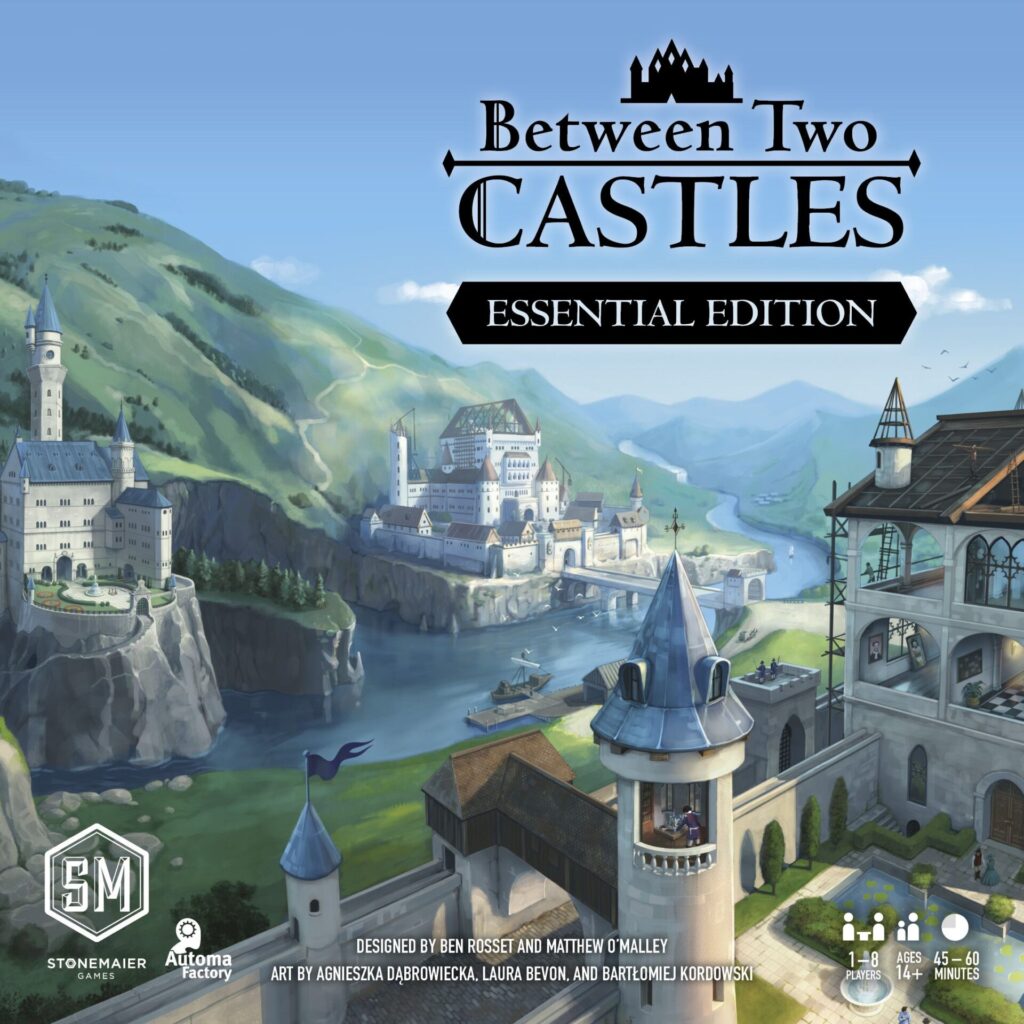
Between Two Castles: Essential Edition (2025)
Design: Matthew O’Malley, Ben Rosset
Publisher: Stonemaier Games
Art: Laura Bevon, Agnieszka Dabrowiecka, Bartłomiej Kordowski
Players: 1-8
Playing time: 60 mins
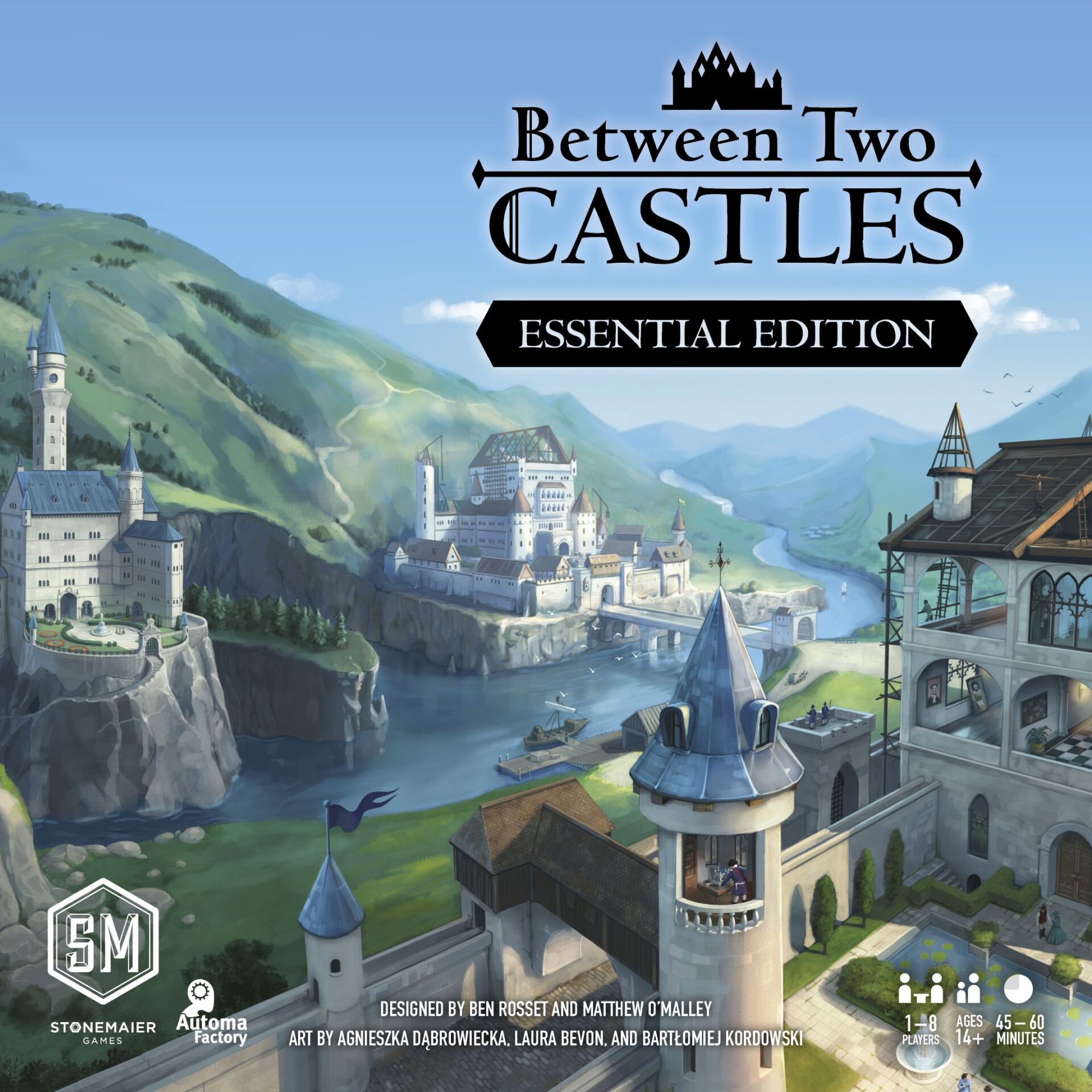
Thanks a lot for the article! It was really helpful